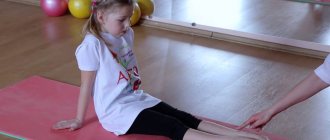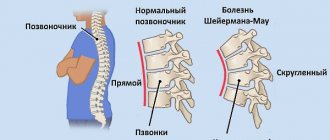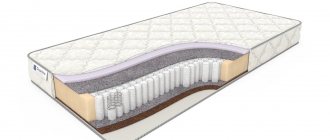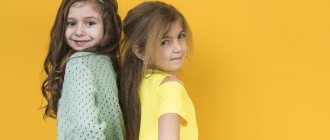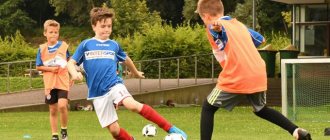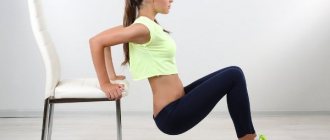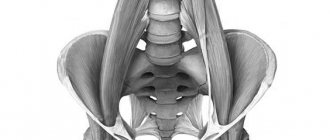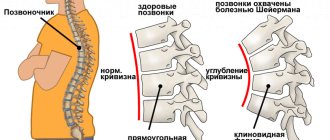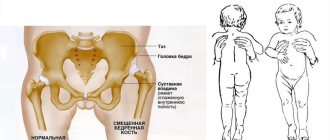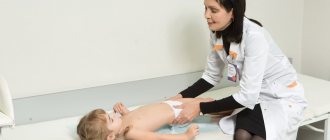At the initial stage, scoliotic posture may not be noticeable to the naked eye. Therefore, correction is started too late, when a stable deformity has already formed with displacement of the vertebral bodies in the lateral projection. This condition negatively affects the condition of the internal organs of the chest, the intervertebral vertebrae quickly wear out, and the blood supply to the heart muscle and brain structures is disrupted.
With scoliotic posture, the child experiences chronic oxygen starvation of all internal organs and cerebral structures. This is due to the fact that the vital volume of the lungs is disrupted and not enough oxygen enters the blood. This can become a trigger for starting the process of pathological changes in organ tissues.
The immune system is the first to react to scoliotic postural disorders in children: the baby begins to suffer from colds, viral and bacterial infections, often and for a long time. In the future, bronchitis with an asthmatic component and tonsillitis may develop.
Scoliotic curvature is a lateral deformity with persistent structural changes. Gradually, torsional displacement of the vertebral bodies and deviation relative to the central axis occurs. With compensatory twisting of the spinal column around its own axis, the position of the vertebral bodies is disrupted, and secondary deformation of the intervertebral joints occurs. As a result of this process, degeneration of the ligamentous and tendon apparatus begins.
The scoliotic spine is a complex deformity that affects the entire spine: cervical, lumbar and lumbosacral. The point of deformation in this case may be the thoracic spine. The conjugate sections suffer from deviation of the vertical axis. There is an increase in physiological bends in the anteroposterior direction.
Without timely comprehensive treatment, a patient with scoliotic curvature of the spinal column may experience serious deformation of the chest with a decrease in the vital volume of the lungs, compression of the heart muscle and deviation of the coronary bloodstream, which entails a secondary form of cardiovascular failure. A long-term negative consequence is deformation of the pelvic bones with divergence of their symphyses and secondary destruction of the hip joints. Shortening of one of the lower limbs, development of a hump, and dysfunction of internal organs may be observed.
It is necessary to begin correction and treatment of the scoliotic spine in the early stages. If there is a serious deformity of the spine in the lateral projection, surgery will be required to restore the physiological structure of the spinal column.
If you need advice from an experienced vertebrologist or orthopedist, you can get it completely free of charge in our manual therapy clinic. Make an appointment for your first appointment at a time convenient for your visit. The doctor will conduct an examination, review the results of the examinations and tell you how to carry out an effective course of correction.
How to determine scoliotic posture. Causes of occurrence.
Scoliotic posture is a pathological change in the spine, in which individual vertebrae are displaced relative to each other in the lateral plane
DRAWING:
Scoliotic posture is the position of the spine.
How is scoliotic posture determined?
Scoliotic posture in a child is characterized by the following signs:
– shoulder joints are located at different heights;
– the blades are located asymmetrically relative to each other;
– the spaces (triangles) between the waist and arms are not the same shape.
Scoliotic posture photo:
Scoliotic posture in a child and scoliosis are two different things.
Scoliosis is different in that when the child lies down or leans forward, the signs of poor posture described above do NOT disappear. With scoliosis, individual vertebrae can also “twist” relative to the vertical axis (this can be seen with an x-ray). Therefore, scoliosis is much more difficult to treat than scoliotic posture.
In any case, before taking any treatment measures, it is necessary for an accurate diagnosis to be made by a doctor.
If you want to get an online consultation with a doctor (ORTHOPEDIST or any other), then follow the link:
— FREE ONLINE DOCTOR CONSULTATIONS —
The causes of scoliotic posture in children can be divided into two parts.
The first reason includes congenital or acquired diseases that lead to lateral curvature of the spine.
The second group of reasons includes the general characteristics of most modern children. These are: weak back and abdominal muscles, low mobility, spending a long time sitting on a chair at a table.
The general causes of scoliotic posture have certain causes. In children and adolescents, bone tissue is actively formed, and growth outstrips the formation of muscle tissue. This is one of the first causes of most postural disorders in children.
Another main reason for the appearance of scoliotic posture in children and adolescents is the child’s lifestyle, in which he is forced to sit at a table for several hours a day (studying at school, doing homework, working at the computer).
The essence of the problem of prolonged sitting in a chair is that in this position fundamental changes occur in the position of the child (adolescent).
How does scoliotic posture occur?
The child’s position – sitting on a chair – is initially NOT physiological for the human skeleton. In order to maintain the correct position of the back and spine while sitting, it is necessary to have strong, well-developed muscles of the back and lumbar muscles.
As we mentioned above, in children the formation and growth of muscle tissue lags behind the formation and growth of skeletal bones.
The conclusion is clear: during prolonged sitting, almost all children and adolescents develop various types of postural disorders, including scoliotic posture.
When a sitting child's back muscles get tired, he begins to look for another, new position in order to relax the tired muscles as much as possible. Very often, in this case, the child brings the elbow (usually the right) hand forward and places it on the table, leaning on this hand. It is in this position that curvature of the spine occurs in the lateral plane.
DRAWING:
A SITTING CHILD WITH SCOLIOTIC POSTURE:
If a child remains in such an incorrect position for quite a long time, he develops “muscle memory” of this position of the spine. Further, such an incorrectly curved position of the spine can persist in other body positions: standing, while walking.
This incorrect position of the spine occurs when a child writes or works with a computer mouse. Due to the fact that these actions are usually performed with the right hand, scoliotic posture in a child most often occurs with a curvature of the thoracic spine with an arc directed to the right side.
PHOTO: SCOLIOtic POSTURE.
Posture: basic concepts
Posture is a habitual position in which a person’s back is in an upright position. In the first years of life, children develop natural curves of the spine. By the time the child goes to school, these curves are more clearly defined. The spine itself begins to form during the development and growth of the child.
Signs of correct posture:
- the collarbones are at the same level;
- when viewed from behind, the shoulder blades and shoulders are located symmetrically;
- head, hips and torso on the same line;
- the stomach is retracted;
- the legs are the same length.
Scoliotic posture in children treatment.
It makes no sense to make comments to a child who is sitting incorrectly so that he “sits up straight.” The child is simply physically unable to maintain the correct position of the back and spine for a long time while sitting on a chair. Reason: underdeveloped back and lumbar muscles, which are directly responsible for the correct position of the spinal column.
In order for the treatment of scoliotic posture in a child to be successful, it is necessary to influence the TWO MAIN CAUSES of the majority of postural disorders in children (including scoliotic posture):
— eliminate the occurrence of scoliotic posture during prolonged sitting on a chair;
— strengthen the muscles that are directly responsible for the child’s correct posture.
There are three methods that correct scoliotic posture and eliminate its occurrence. Let's analyze them all.
The first method: wearing a posture corrector (price 1200-1500 rubles).
PHOTO OF POSTURE CORRECTOR:
The essence of using a corrector is as follows.
The posture corrector is used (put on) for 30-40 minutes, several times a day. The special cut and materials of the corrector determine the correct position of the child’s back and shoulders. If the child wants to assume an incorrect position of the shoulders and back, the posture corrector straps put pressure on the shoulder joints, thereby reminding and correcting exclusively the correct position of the back and shoulder joints.
As a result of regular use in a child:
- The muscles that are responsible for correct posture work and strengthen;
- “Muscle memory” of the correct position of the back, shoulders and spine is developed.
These two factors make it possible to prevent and, as a result of regular use, correct scoliotic posture in a child.
When choosing a posture corrector, you need to choose the right size. If the size is slightly larger than required, then the desired effect from wearing the corrector will not appear. True, children grow quite quickly, and in this case it will be possible to effectively use the corrector after some time.
The only disadvantage of using a posture corrector is the fact that children grow and develop quite quickly. Therefore, after a certain time, if you want to continue using a corrector to correct or prevent scoliotic posture in a child, you will have to purchase a larger corrector.
But with the average price of a posture corrector being 1200-1500 rubles (it’s not worth buying cheaper, due to poor quality), this drawback of the corrector is not very relevant.
You can read more about how a posture corrector works, and how to select and order a corrector, in the article “BACK CORRECTOR”. (the page with the article will open in a new additional “window”).
……………………………………………
HOW TO CHOOSE A POSTURE CORRECTOR:
What to do if you have scoliotic-type posture problems?
Poor posture of the scoliotic type can be successfully treated with conservative methods only at an early stage of the disease. If there is a serious deviation from the central axis of the spinal column, surgery is required.
There are no pharmacological drugs that can restore the normal position of the vertebrae. Wearing special corsets can only aggravate the situation.
The use of manual therapy methods is effective. In our clinic, the doctor individually develops a course of treatment. It may include physical therapy and kinesiotherapy, osteopathy and massage, traction traction of the spinal column, laser and physiotherapeutic effects.
If you need qualified help to correct the scoliotic type of curvature of the spinal column, then sign up at our clinic for a free initial consultation with a vertebrologist. We accept children from the age of five.
— Buy a magnetic corset from an official seller, with delivery: 1290 rubles. (LINK) -
……………………………………………
The second method, which corrects scoliotic posture in a child and eliminates its occurrence: the use of a special Tolstunov seat-simulator, which is also known under the names: “Back OK” and the seat-simulator “Doctor Cypress”.
The cost of a seat-simulator is from 3500 rubles.
PHOTO: EXERCISER SEAT “DOCTOR CYPRESS” FOR TREATMENT OF SCOLIOTIC POSTURE IN CHILDREN.
PHOTO OF AN EXERCISER SEAT FOR TREATMENT OF SCOLIOTIC POSTURE IN CHILDREN.
The essence of using a seat-simulator is that the child sits on an inclined surface of the seat. This allows you to preserve the natural curves of the child’s spine!
The exercise seat can be installed on any chair. If a child sitting on a simulator tries to take a position in which his spine is curved in the lateral plane (a sign of scoliotic posture), then he simply CANNOT do this! In this incorrect position, the muscles of his lumbar region will be greatly overstrained, and the child will be forced to take the correct position of the body. Moreover, without any reminders from you. And this is a very big plus.
The second no less important positive point.
By changing the position on the seat of the exercise machine (you can sit moving a little forward, or a little further back), a sitting child will be able to independently train deep-lying muscle fibers (back and lower back). These muscles are difficult to engage and strengthen even when working out in the gym.
Another advantage of the exercise seat is that it can be used by both a child and an adult (up to 130 kg). Therefore, this product is purchased once and used for many years.
For more information about how to use the exercise machine correctly, as well as read reviews from Dr. Bubnovsky and other orthopedists, you can click on the link “DOCTOR CYPRESS SEAT-TRAINER” (the page will open in a new additional “window”).
The third method, which corrects scoliotic posture in a child and eliminates its occurrence: is the use of an orthopedic chair with emphasis on the knees (price: from 5950 rubles).
DRAWING OF A KNEEING CHAIR.
Orthopedic chair for the treatment of scoliotic posture.
Photo of an orthopedic chair for correcting scoliotic posture.
This machine also uses a reclining seat. This allows the sitting child to preserve the natural curves of the spine. The popliteal support of the simulator eliminates any possibility of a body position in which the child develops a lateral curvature of the spine (scoliotic posture).
You can read more about the features of using an orthopedic chair with support for the knees by clicking on the link: “ORTHOPEDIC CHAIR WITH SUPPORT FOR KNEES” (the page opens in a new additional “window”).
What is the fundamental difference between using the seat of the “Doctor Cypress” (“Back OK”) exercise machine, described just above, and using an Orthopedic chair with emphasis on the knees?
The seat on the orthopedic chair is static.
The seat of the “Doctor Cypress” (“Back Okay”) simulator is installed and secured to an articulated joint. That is, it is not sustainable in itself. Therefore, such an unstable seat allows you to more effectively strengthen the deep back muscles and abdominal muscles of the lumbar region of the child. Initially, the Doctor Cypress seat simulator is used for half an hour. Then gradually increase the duration of sitting on it.
The orthopedic chair is suitable for permanent use.
Ultimately, both devices fulfill their main task:
correct and prevent the occurrence of scoliotic posture in a child. Since using both methods, the child will not be able to assume an incorrect position, which would result in a lateral curvature of the spine (scoliotic posture).
In addition, the use of both an exercise seat and an orthopedic chair develops “muscle memory” of the correct position of the child’s back and spine. This is a very important point for developing and consolidating the habit of maintaining correct posture.
A comparative table of three methods for correcting scoliotic posture and its further prevention (as well as other types of postural disorders in a child).
“BACK CORRECTOR”. | Advantages: Best price. Trains and strengthens the muscles responsible for correct posture. Develops “muscle memory” of the correct position of the back and spine. Disadvantage: as the child grows, you need to purchase a larger size corrector. Usage: 30 minutes several times a day. |
From 3500 rubles
(different design models).
“ORTHOPEDIC CHAIR WITH KNEES”
Advantages: Trains and strengthens the muscles responsible for correct posture. Develops “muscle memory” of the correct position of the back and spine.Use: for permanent use while working while sitting at a desk.
From 5950 rubles - metal construction is preferable; wooden structures creak and become loose over time
Fabric upholstery is preferable. Leatherette cracks and tears over time.
The use of the products described above allows you to train and strengthen the back muscles, which are directly responsible for the child’s posture. If free time allows, it will also be useful to perform some exercises that are specifically designed to strengthen those muscles that need to be strengthened to prevent the child from having scoliotic posture.
Exercises for preschoolers
Warm-up
"Sparrow"
We stand up straight, put our hands on our belts. We move our elbows to the side, bring our shoulder blades together, and inhale. We stand up straight, put our hands on our belts, and exhale.
“I want to reach the sun”
We stand on our toes, raise our arms above our heads, lock them together and stretch, higher, even higher. We walk around the room. 20–25 steps.
"Walking - half squat"
We put the handles on the belt. We walk around the room in a half-squat. 20–25 steps.
"Walking on your heels"
We stand on our heels. We connect the handles into a lock behind the back. We walk around the room. 20–25 steps.
"Tilts"
We place the legs shoulder-width apart, the arms on the shoulders.
Let's take a deep breath.
We lean forward, keep our back straight, and exhale.
Strengthening the back muscles
"Fish"
Count - one, two. We lie down on our tummy. We stretch our arms in front of us. Once, we raise our legs, upper body, head, arms. Two - we lie down on our tummy. We stretch our arms in front of us. Let's exhale.
"Breaststroke"
Count - one, two... eight. We lie down on our tummy. We extend our arms in front of us. Once - raise the upper body, head, arms. Two, three... seven - move the handles. It's like we're swimming breaststroke. Eight - rest.
"Starfish"
Counting - one, two, three, four. We lie down on our tummy. We extend our arms in front of us. Once, we raise our arms, upper body, head, legs. Two - we spread the arms and legs to the side. Three - arms in front of you, legs connected. Four - rest.
"Diver"
Count - one, two... eight. We lie down on our tummy. We extend our arms in front of us. Once, we raise our head, upper body, arms, legs. Two, three, ... seven - move your legs up and down. Eight - rest.
"Ship"
Count - one, two... eight. We lie down on our tummy. We stretch our arms in front of us. Let's take a breath. Once, we raise our heads, shoulders, bend, and move our arms back. Two, three... seven - we hold on. Eight - rest.
Strengthening the abdominal muscles
"Catamaran"
The count is one, two... seventeen. We sit down on the mat. We rest our hands on the back. Raise your legs above the floor. One, two... sixteen - we press the “invisible” pedals with our feet. Seventeen - rest.
"Mermaid"
Count - one, two... ten. We get on our knees. We move the handles to the side. One, two - we sit on the right thigh, pull the right arm down to the left. Three, four - we get down on our knees. We move the handles to the side. Five... eight - we sit on the left thigh, pull the left arm down to the right. Nine, ten - we get to our knees. Let's rest.
"Squid"
Counting - one, two, three, four. We sit down on the mat. We rest our hands on the back. Once, bend your legs, pull your knees to your chest. Two - we straighten our legs, lift them up and spread them apart. Three - we connect the legs. Four - we sit on the mat.
"Jellyfish"
Counting - one, two, three, four. We lie on our backs, spread our legs and arms to the sides. Once, we bend the legs. We wrap our arms around the shin. We raise our heads to our knees. “We shrink like a jellyfish.” Two, three - we hold the “jellyfish” figure. Four - lie on your back, spread your legs and arms to the sides.
